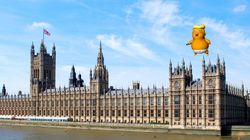
Donald Trump’s visit to the UK this week will put extreme pressure on forces around the country, police chiefs have warned ahead of the biggest mobilisation of officers since the 2011 London riots.
One chief constable told The Guardian that the resources requested were on the scale required “if London was burning down”.
During his two-day trip to the UK Trump will spend time in London, Windsor and Scotland, avoiding the mass protests planned in the capital and at other key sites.
Thousands of people are expected to join marches opposing his visit, with a giant inflatable orange “Trump baby” due to fly over Westminster.
Forces from across the country will be sending officers to London to assist. Police chiefs have warned that forces are being pushed to the limit, saying they “cannot do it all” and that “choices have to be made”.
Under the so-called “mutual aid” agreement, forces assist one another outside their regions when dealing with large-scale incidents and emergencies.
The Police Federation of England and Wales (PFEW) said that Trump’s visit will place “unquestionable pressure” on a service “already creaking at the knees”.
Simon Kempton, operational policing lead for PFEW, said thousands of officers will be deployed from their home forces.
“The fact cannot be ignored that while the officers on mutual aid are deployed elsewhere thousands more of their colleagues left behind in their home force will be expected to pick up the slack leaving them even more stretched,” Kempton said.
“There was a time when we could do it all but now choices have to be made – we cannot do it all and this type of event puts a service which is already creaking at its knees under unquestionable pressure.”
Largest protests London has seen:
1. Anti-War protest, estimated 750,000 people
Hailed as the biggest demonstration Britain has ever seen, the Stop the War protest in London in February 2003 saw 750,000 people take to the streets of the capital, according to police figures. Organisers put the figure even higher, claiming up to two million people took park to protest the Iraq War.
2. Anti-cuts march, estimated 400,000 people
Demonstrators marched from Embankment to Hyde Park in response to austerity measures imposed by the Conservative-Lib Dem coalition government. The biggest union-organised event for more than 20 years saw more than 800 coaches hired to ferry people to the capital.
3. Pro-hunting demonstration, estimated 400,000 people
In September 2002 an estimated 400,000 people descended on central London for the Liberty and Livelihood march in a bid to protect rural communities’ right to hunt. The main focus of the protest was to oppose a ban on hunting with dogs in England and Wales, despite 74% of the British population supporting a ban at the time.
Trump’s working visit lacks the accolade of a full state visit, but his presence on British soil will be met with demonstrations opposing his sexism, racism and treatment of migrants.
Following security concerns, the President’s itinerary has been shrouded in secrecy for months, but his schedule was finally announced by Downing Street on Friday.
Amid security worries, intense secrecy has shrouded the President’s plans for months, but Downing Street finally announced details of the event on Friday.
Trump will arrive on Thursday, when he will come directly from the NATO summit in Brussels. Theresa May will then host him and the First Lady for a black-tie business dinner at Blenheim Palace.
The President and Melania Trump will then overnight at Winfield House, the US ambassador’s residence in the middle of Regent’s Park. At both Blenheim and Winfield House, large protests are planned.
On Friday, the pair will travel to Chequers in Buckinghamshire for bilateral talks on a range of foreign policy issues with May.
In the afternoon they will then travel to Windsor Castle to meet the Queen, before they fly to Scotland.
Kempton warned that during this period forces across England and Wales are “likely to become a merely reactive service”, with the World Cup placing even greater strain on resources.
“You have to ask what would happen if were unable to resource incidents like these,” Kempton said.
“Would we see the situation where the military were drafted in place of police officers? Green uniforms instead of the blue ones people would – and should – expect to see? It’s a worrying prospect.”

